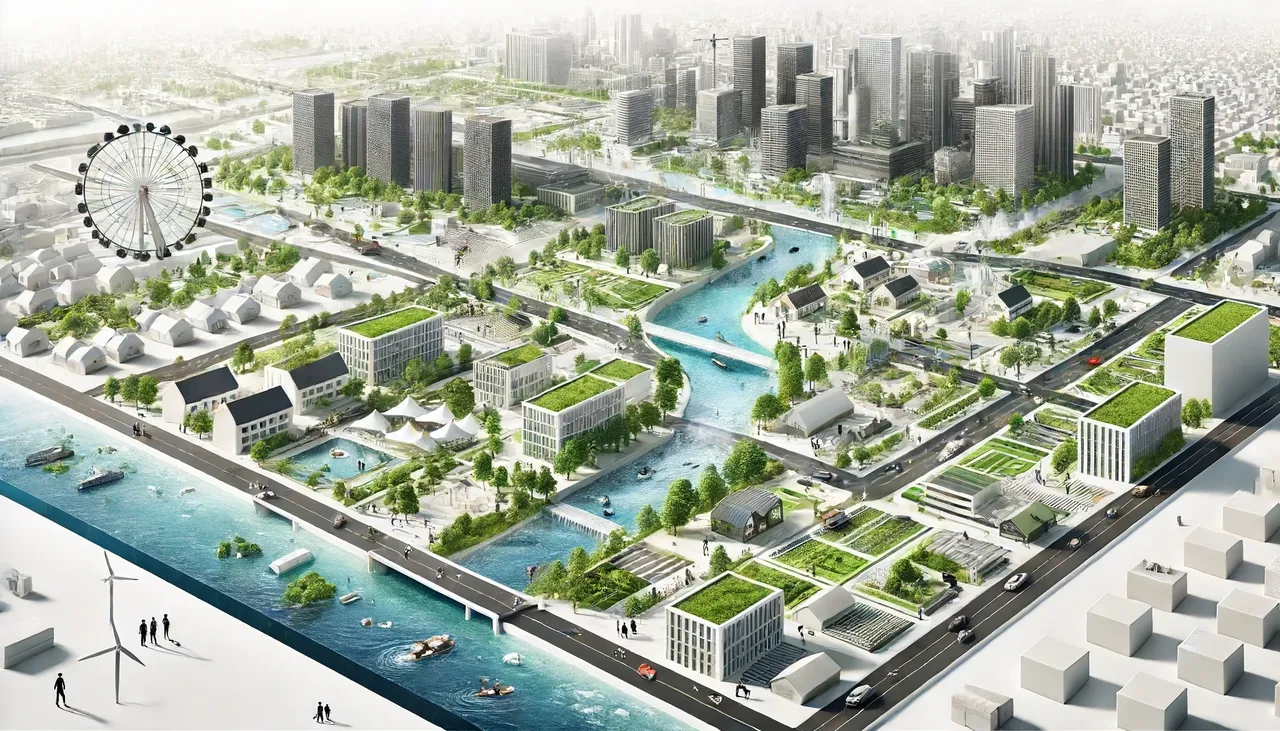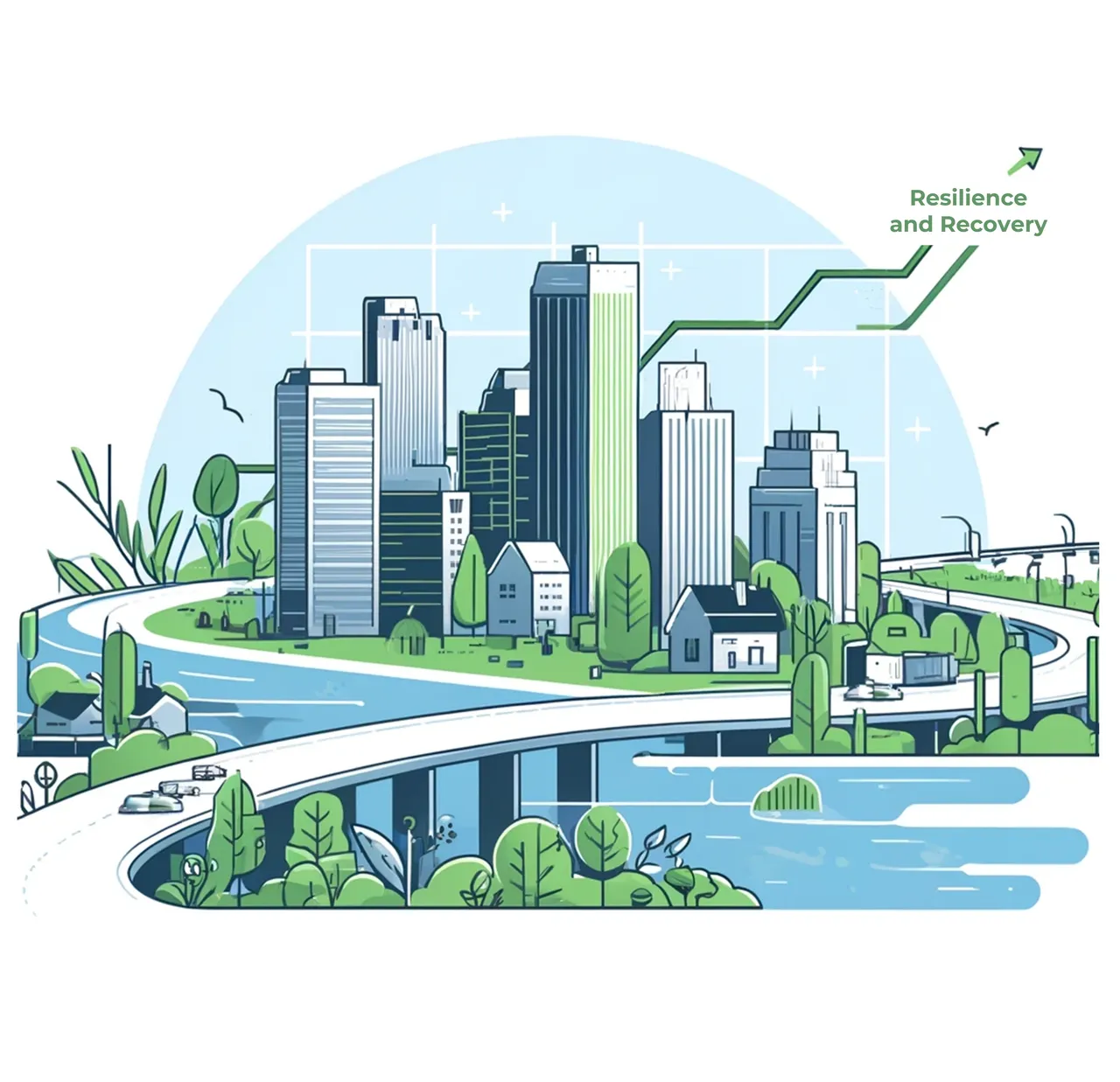· Blog · 4 min read
Urban Resilience - Navigating Natural Disasters and Urban Growth
An urban landscape showcasing resilient infrastructure designed to withstand natural disasters. The scene highlights flood-resistant buildings, green rooftops, permeable pavements, and stormwater management systems, demonstrating innovation and community resilience.

Natural disasters are a stark reminder of our vulnerability to the forces of nature. From hurricanes and earthquakes to floods and wildfires, these events can devastate communities, disrupt economies, and reshape landscapes. In the face of such challenges, resilience has emerged as a crucial concept in urban development and disaster management.
Understanding Resilience in Natural Disasters
Resilience in the context of natural disasters involves the capacity of communities to withstand, adapt to, and recover from such events. This means not only bouncing back to a pre-disaster state but also improving and transforming to better cope with future risks. The goal is to build communities that are not just surviving but thriving in the face of adversity.
Example: After the 2010 earthquake in Haiti, which caused widespread destruction and loss of life, international aid efforts focused not only on immediate relief but also on long-term resilience. This included rebuilding infrastructure to better withstand future earthquakes, enhancing emergency response capabilities, and empowering local communities through education and economic opportunities.
Urban Development and the Challenges of Resilience
Urban development presents unique challenges and opportunities for building resilience. Cities are complex systems where social, economic, and environmental factors intersect. The rapid pace of urbanization often leads to increased exposure and vulnerability to natural disasters. However, it also provides a platform for innovative solutions and strategies to enhance resilience.
Case Study: The Red River Valley Floods
The Red River Valley in Manitoba, Canada, has faced numerous floods despite extensive flood prevention and mitigation measures. Policies often placed the initial responsibility on individuals before higher authorities stepped in. Despite these efforts, the region has repeatedly suffered significant damage, highlighting the need for more integrated and proactive resilience strategies.
Example: In response to the recurrent flooding, the Red River Floodway was constructed to divert excess water away from the city of Winnipeg. This engineering solution has significantly reduced flood risk. However, ongoing urban development in flood-prone areas continues to challenge resilience efforts, underscoring the need for comprehensive land-use planning and community engagement.
Case Study: Hurricane Katrina
The devastation caused by Hurricane Katrina in Louisiana, USA, exposed the limitations of existing disaster management and urban development policies. Despite extensive hurricane protection projects and subsidized flood insurance, the region faced catastrophic losses. This tragedy underscored the importance of not just physical infrastructure but also social policies that support resilience.
Example: In the wake of Hurricane Katrina, the city of New Orleans implemented a series of resilience initiatives, including the construction of new levees and floodwalls, investment in green infrastructure like rain gardens and wetlands, and community-based disaster preparedness programs. These efforts aim to create a more resilient city capable of withstanding future hurricanes and other natural disasters.
Moving Forward: Strategies for Resilient Urban Development
To build resilient urban environments, we must integrate resilience into every aspect of urban planning and development. This involves:
Risk Assessment and Preparedness
Developing comprehensive risk assessments and preparedness plans that consider the unique vulnerabilities and strengths of each community.
Example: Tokyo, Japan, has implemented an extensive earthquake preparedness plan that includes regular drills, early warning systems, and stringent building codes designed to withstand seismic activity. These measures have significantly enhanced the city’s resilience to earthquakes.
Sustainable Infrastructure
Investing in infrastructure that is not only robust but also adaptable to changing conditions.
Example: Copenhagen, Denmark, has developed a “Climate Resilient Neighborhood” project that incorporates green roofs, permeable pavements, and stormwater management systems to reduce the impact of heavy rainfall and flooding. This approach not only mitigates flood risk but also enhances urban livability and environmental sustainability.
Community Engagement
Involving local communities in the planning and decision-making processes to ensure that resilience strategies are grounded in local knowledge and needs.
Example: The “100 Resilient Cities” initiative, pioneered by the Rockefeller Foundation, works with cities around the world to develop resilience strategies through collaborative planning and community engagement. Cities like Medellín, Colombia, have implemented innovative solutions such as cable cars and green corridors to enhance urban resilience and social cohesion.
Policy Integration
Ensuring that policies at all levels of government support and enhance resilience rather than undermine it.
Example: The Netherlands has implemented a comprehensive “Room for the River” program that integrates flood management with urban development. This policy allows for controlled flooding in designated areas to protect densely populated regions, demonstrating how integrated policy approaches can enhance resilience.
Conclusion
Building resilience in the context of natural disasters and urban development is a complex but essential task. It requires a holistic approach that combines physical, social, and policy measures. By learning from past experiences and integrating resilience into all aspects of urban planning, we can create cities that are better prepared for the challenges of the future.


